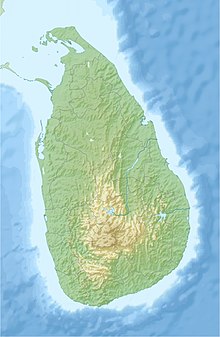Sri Pada
| Adam's Peak | |
|---|---|
| Sri Pada (සමනළ කන්ද) | |

Adam's Peak from a distance
|
|
| Highest point | |
| Elevation | 2,243 m (7,359 ft) |
| Coordinates | 06°48′41″N 80°29′59″E / 6.81139°N 80.49972°ECoordinates: 06°48′41″N 80°29′59″E / 6.81139°N 80.49972°E |
| Geography | |
| Location | Sabaragamuwa, Sri Lanka |
| Parent range | Samanala |
Adam's Peak (Sinhalese: Sri Pada or "Sri Paadaya" (ශ්රී පාදය) and Samanalakanda, සමනළ කන්ද; Lit. "Butterfly Mountain"; Tamil: சிவனொளி பாதமலை, Sivanolipatha Malai; Arabic: Al-Rohun) is a 2,243 m (7,359 ft) tall conical mountain located in central Sri Lanka. It is well known for the Sri Pada, i.e., "sacred footprint", a 1.8 m (5 ft 11 in) rock formation near the summit, which in Buddhist tradition is held to be the footprint of the Buddha, in Hindu tradition that of Shiva and in Islamic and Christian tradition that of Adam, or that of St. Thomas.
The mountain is located in the southern reaches of the Central Highlands, in the Ratnapura District and Nuwara Eliya district of the Sabaragamuwa Province and Central Province —lying about 40 km northeast of the city of Ratnapura and 32 km southwest of the city of Hatton. The surrounding region is largely forested hills, with no mountain of comparable size nearby. The region along the mountain is a wildlife reserve, housing many species varying from elephants to leopards, and including many endemic species.
Adam's Peak is important as a watershed. The districts to the south and the east of Adam's Peak yield precious stones—emeralds, rubies and sapphires, for which the island has been famous, and which earned for its ancient name of Ratnadvipa.
Access to the mountain is possible by 6 trails: Ratnapura-Palabaddala, Hatton-Nallathanni, Kuruwita-Erathna, Murraywatte, Mookuwatte & Malimboda. The Nallathanni & Palabaddala routes are most favored by those undertaking the climb, while the Kuruwita-Erathna trail is used less often; these trails are linked to major cities or town by bus, accounting for their popular use. The Murraywatte, Mookuwatte & Malimboda routes are hardly used, but do intersect with the Palabaddala road midway through the ascent. The usual route taken by most pilgrims is ascent via Hatton and descent via Ratnapura; although the Hatton trail is the steepest, it is also shorter than any of the other trails by approximately five kilometers.
...
Wikipedia

